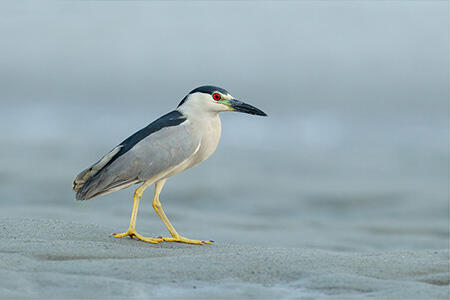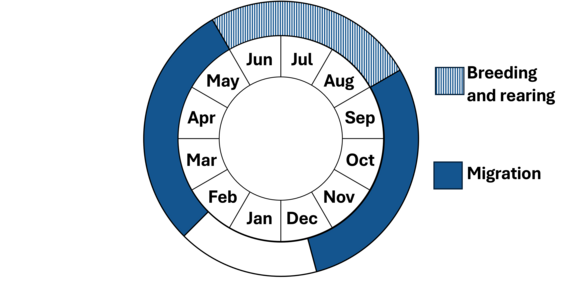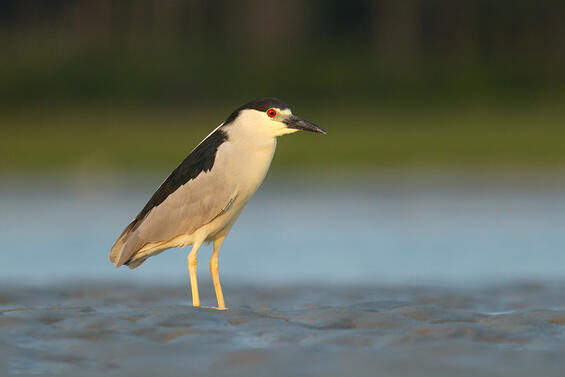- Scientific name: Nycticorax nycticorax
Species of Greatest Conservation Need (MA State Wildlife Action Plan)
Description

Black-crowned night heron (Nycticorax nycticorax)
A stocky, thick-billed, short-legged heron, black-crowned night herons range from 58-66 cm (22-26 in) in length, weigh 727-1,104 g (25.6-35.8 oz), and have a wingspan of 115-118 cm (45.3-46.5 in). Breeding birds have a blackish back and black cap, contrasting with light underparts, and two white head plumes. Immature individuals are brown with large white spots on the wings and streaks on the underparts. The voice is a flat quok!, most often heard at dusk.
Life cycle and behavior

When seen during the day, these herons are usually inactive, with a hunched posture, perched on a tree limb or hidden among branches. At dusk, black-crowned night herons fly to their feeding areas. They are social year-round and will often nest and roost in groups.
The male will choose a nest site in a tree or in cattails in a swamp, over water, or on an island. Since the black-crowned night heron nest colonially, it’s not unusual to have over a dozen nests in one tree. The male will build the nest with woody vegetation. Once the female joins, she will help finish the nest. The female will lay 3-5 eggs and will incubate them for 24-26 days. The young move about the nest tree around 1 month. They can fly around 6 weeks old and will disperse shortly afterward.
Population status
Partners in Flight estimate the global breeding population to be 3 million. Black-crowned night herons are widely distributed along the Massachusetts coast but have strongly declined over the last several decades. In 1994-95, 1,420 pairs were reported from 19 nesting colonies, but these numbers have steadily declined with 581 pairs being documented in the state-wide Colonial Waterbird Survey.
Distribution and abundance
According to the North American Breeding Bird Survey, black-crowned night herons were stable in most areas between 1966 and 2019. In Massachusetts, this species formerly nested in the Connecticut River Valley into the 1930s but is now uncommon at locations more than 20 miles from the coast. Post-breeding assemblages of roosting or feeding birds sometimes occur in summer or early fall at locations widely separated from the nesting colonies.

Black-crowned night heron (Nycticorax nycticorax)
Habitat
Habitats of black-crowned night herons in Massachusetts include salt marshes and tidal flats, fresh and brackish marshes, ponds, and creeks. Night herons are primarily nocturnal and crepuscular foragers on small fish, amphibians, crabs and other crustaceans, and insects. Occasionally, they feed on the eggs and young of gulls and terns. These herons nest colonially in trees or shrubs, often in mixed-species assemblages with other herons. Often the vegetation used for nesting is eventually killed by years of accumulating excrement, forcing the herons to seek another colony site.
Healthy habitats are vital for supporting native wildlife and plants. Explore habitats and learn about conservation and restoration in Massachusetts.
Threats
Threats to this species include human disturbance at nesting colonies, destruction of woody vegetation used for nesting, and coastal development that degrades or destroys nesting, roosting, or feeding habitat. Pesticides such as DDT are believed to have impaired reproductive success in the past. Black-crowned night herons are thought to be good indicator species for habitat quality as they have a wide range, are top of the food chain, and can tolerate disturbances from urban environments.
Conservation
Protection and management of nesting colonies is important for the conservation of black-crowned night herons. At some sites, habitat restoration efforts could improve conditions for colony persistence or establishment, especially at sites that formerly hosted colonies but where the habitat is no longer suitable.
References
Davis, W. E., Jr. “Black-crowned Night-Heron (Nycticorax nycticorax).” 1993. The Birds of North America, No. 74 (A. Poole and F. Gill, eds.). Philadelphia: The Academy of Natural Sciences, and The American Ornithologists’ Union, Washington, D.C.
Petersen, W.R., and W.R. Meservey. Massachusetts Breeding Bird Atlas. Amherst, MA: Massachusetts Audubon Society and University of Massachusetts Press, 2003.
Veit, R., and W.R. Petersen. Birds of Massachusetts. Lincoln, MA: Massachusetts Audubon Society, 1993.
Contact
| Date published: | May 15, 2025 |
|---|